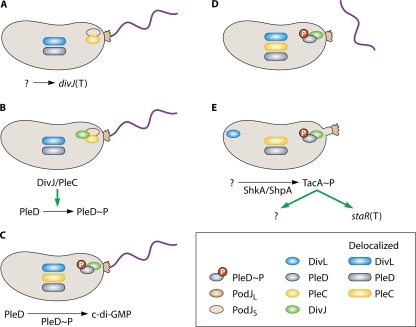FIG. 4.
Swarmer cell differentiation. (A) A mature swarmer cell is indicated by the presence of holdfast at the flagellar pole and the absence of pili. PodJS and PleC are localized to the flagellar pole. PleD is in the nonphosphorylated state and therefore delocalized, as is DivL. An unknown signal leads to DivJ synthesis. (B) DivJ is synthesized and localizes to the flagellar pole. For a brief period of time, PodJs, PleC, and DivJ all inhabit the same pole. DivJ and/or PleC phosphorylate PleD (see “Swarmer → Stalked Cell Transition” in the text), causing a subpopulation to localize to the developing pole. (C) PodJS is degraded by an unknown mechanism, and PleC becomes delocalized. PleD∼P catalyzes the formation of c-di-GMP. (D) Production of c-di-GMP leads to morphological changes in the cell through unknown mechanisms. The flagellum is ejected. (E) Stalk synthesis is initiated, which requires phosphorylation of the sigma 54 activator TacA through the ShkA/ShpA phosphorelay. The signal that leads to ShkA/ShpA/TacA activation is unknown. TacA activation leads to synthesis of the stalk length determinant StaR, as well as other, unidentified targets. Other factors are likely involved in stalk synthesis. It should be noted that the ShkA/ShpA/TacA pathway is present and active in the late predivisional and swarmer cell stages. The mechanism for controlling the timing of stalk synthesis is not understood. The stalk is extended with the holdfast at the tip. DivL localizes to the stalk-distal pole.

